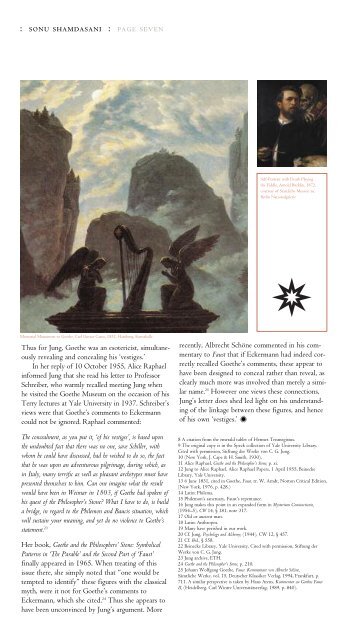a semi-annual publication of the philem n foundation - Philemon ...
a semi-annual publication of the philem n foundation - Philemon ...
a semi-annual publication of the philem n foundation - Philemon ...
You also want an ePaper? Increase the reach of your titles
YUMPU automatically turns print PDFs into web optimized ePapers that Google loves.
: sonu shamdasani : page seven<br />
Memorial Monument to Goe<strong>the</strong>, Carl Gustav Carus, 1832, Hamburg, Kunsthalle<br />
Thus for Jung, Goe<strong>the</strong> was an esotericist, simultaneously<br />
revealing and concealing his ‘vestiges.’<br />
In her reply <strong>of</strong> 10 October 1955, Alice Raphael<br />
informed Jung that she read his letter to Pr<strong>of</strong>essor<br />
Schreiber, who warmly recalled meeting Jung when<br />
he visited <strong>the</strong> Goe<strong>the</strong> Museum on <strong>the</strong> occasion <strong>of</strong> his<br />
Terry lectures at Yale University in 1937. Schreiber’s<br />
views were that Goe<strong>the</strong>’s comments to Eckermann<br />
could not be ignored. Raphael commented:<br />
The concealment, as you put it, ‘<strong>of</strong> his vestiges’, is based upon<br />
<strong>the</strong> undoubted fact that <strong>the</strong>re was no one, save Schiller, with<br />
whom he could have discussed, had he wished to do so, <strong>the</strong> fact<br />
that he was upon an adventurous pilgrimage, during which, as<br />
in Italy, many terrific as well as pleasant archetypes must have<br />
presented <strong>the</strong>mselves to him. Can one imagine what <strong>the</strong> result<br />
would have been in Weimar in 1803, if Goe<strong>the</strong> had spoken <strong>of</strong><br />
his quest <strong>of</strong> <strong>the</strong> Philosopher’s Stone? What I have to do, is build<br />
a bridge, in regard to <strong>the</strong> <strong>Philemon</strong> and Baucis situation, which<br />
will sustain your meaning, and yet do no violence to Goe<strong>the</strong>’s<br />
statement. 23<br />
Her book, Goe<strong>the</strong> and <strong>the</strong> Philosophers’ Stone: Symbolical<br />
Patterns in ‘The Parable’ and <strong>the</strong> Second Part <strong>of</strong> ‘Faust’<br />
finally appeared in 1965. When treating <strong>of</strong> this<br />
issue <strong>the</strong>re, she simply noted that “one would be<br />
tempted to identify” <strong>the</strong>se figures with <strong>the</strong> classical<br />
myth, were it not for Goe<strong>the</strong>’s comments to<br />
Eckermann, which she cited. 24 Thus she appears to<br />
have been unconvinced by Jung’s argument. More<br />
Self-Portrait with Death Playing<br />
<strong>the</strong> Fiddle, Arnold Böcklin, 1872,<br />
courtesy <strong>of</strong> Staatliche Museen zu,<br />
Berlin Nationalgalerie<br />
recently, Albrecht Schöne commented in his commentary<br />
to Faust that if Eckermann had indeed correctly<br />
recalled Goe<strong>the</strong>’s comments, <strong>the</strong>se appear to<br />
have been designed to conceal ra<strong>the</strong>r than reveal, as<br />
clearly much more was involved than merely a similar<br />
name. 25 However one views <strong>the</strong>se connections,<br />
Jung’s letter does shed led light on his understanding<br />
<strong>of</strong> <strong>the</strong> linkage between <strong>the</strong>se figures, and hence<br />
<strong>of</strong> his own ‘vestiges.’S<br />
8 A citation from <strong>the</strong> emerald tablet <strong>of</strong> Hermes Trismegistus.<br />
9 The original copy is in <strong>the</strong> Speck collection <strong>of</strong> Yale University Library.<br />
Cited with permission, Stiftung der Werke von C. G. Jung.<br />
10 (New York, J. Cape & H. Smith, 1930).<br />
11 Alice Raphael, Goe<strong>the</strong> and <strong>the</strong> Philosopher’s Stone, p. xi.<br />
12 Jung to Alice Raphael, Alice Raphael Papers, 1 April 1955, Beinecke<br />
Library, Yale University.<br />
13 6 June 1831, cited in Goe<strong>the</strong>, Faust, tr. W. Arndt, Norton Critical Edition,<br />
(New York, 1976, p. 428.)<br />
14 Latin: Philema.<br />
15 <strong>Philemon</strong>’s sanctuary, Faust’s repentance.<br />
16 Jung makes this point in an expanded form in Mysterium Coniunctionis,<br />
(1954–5), CW 14, § 181, note 317.<br />
17 Old or ancient man.<br />
18 Latin: Anthropos.<br />
19 Many have perished in our work.<br />
20 Cf. Jung, Psychology and Alchemy, (1944), CW 12, § 457.<br />
21 Cf. Ibid., § 558.<br />
22 Beinecke Library, Yale University, Cited with permission, Stiftung der<br />
Werke von C. G. Jung.<br />
23 Jung archive, ETH.<br />
24 Goe<strong>the</strong> and <strong>the</strong> Philosopher’s Stone, p. 210.<br />
25 Johann Wolfgang Goe<strong>the</strong>, Faust. Kommentare von Albrecht Schöne,<br />
Sämtliche Werke, vol. 15, Deutscher Klassiker Verlag, 1994, Frankfurt, p.<br />
711. A similar perspective is taken by Hans Arens, Kommentar zu Goe<strong>the</strong>s Faust<br />
II, (Heidelberg, Carl Wintre Universitätsverlag, 1989, p. 840).


